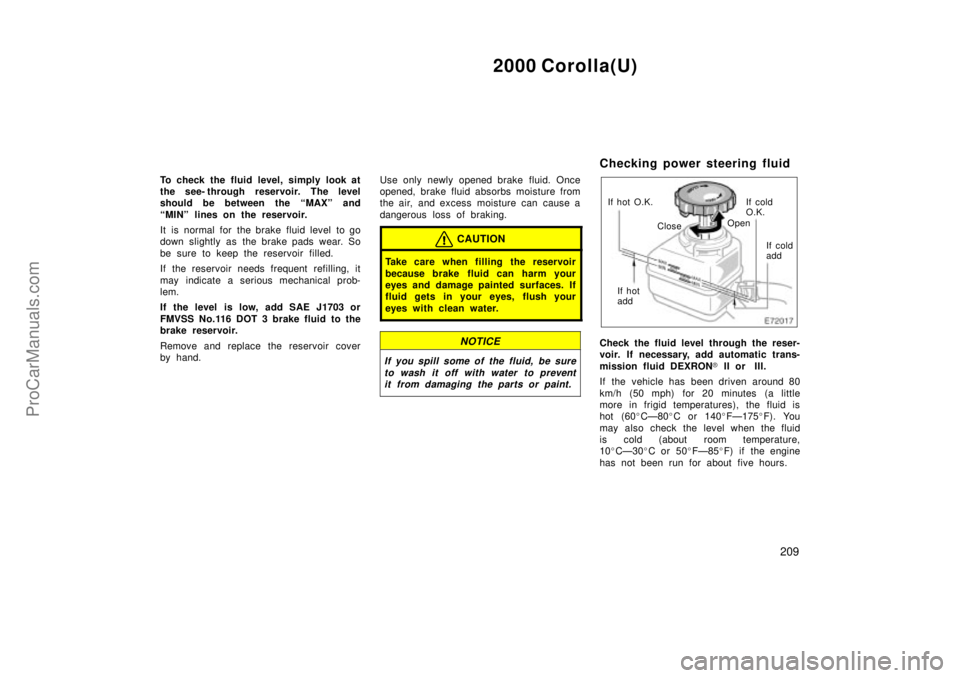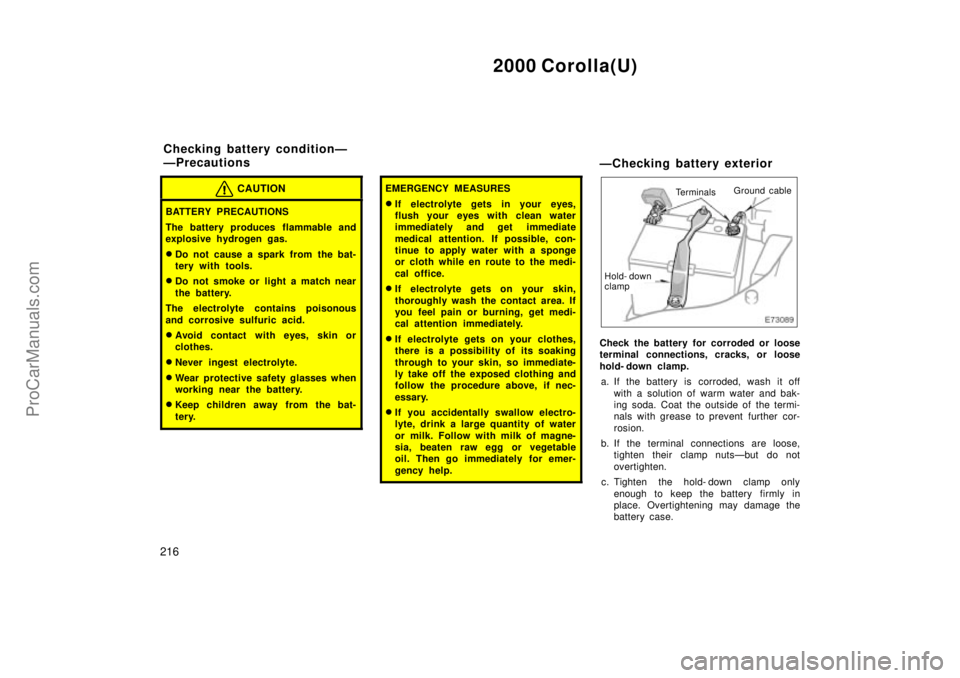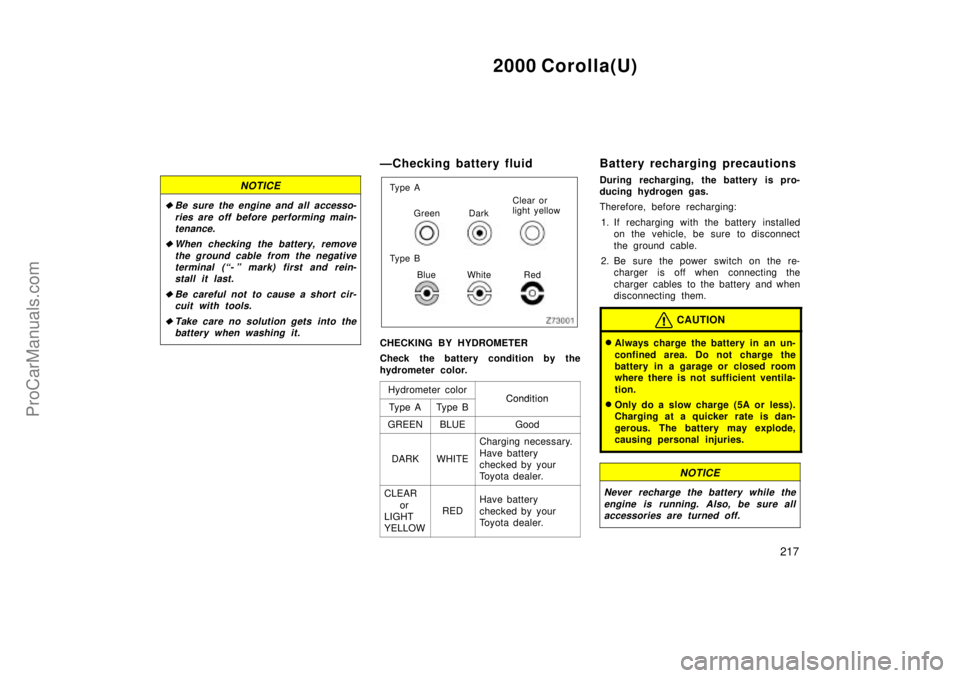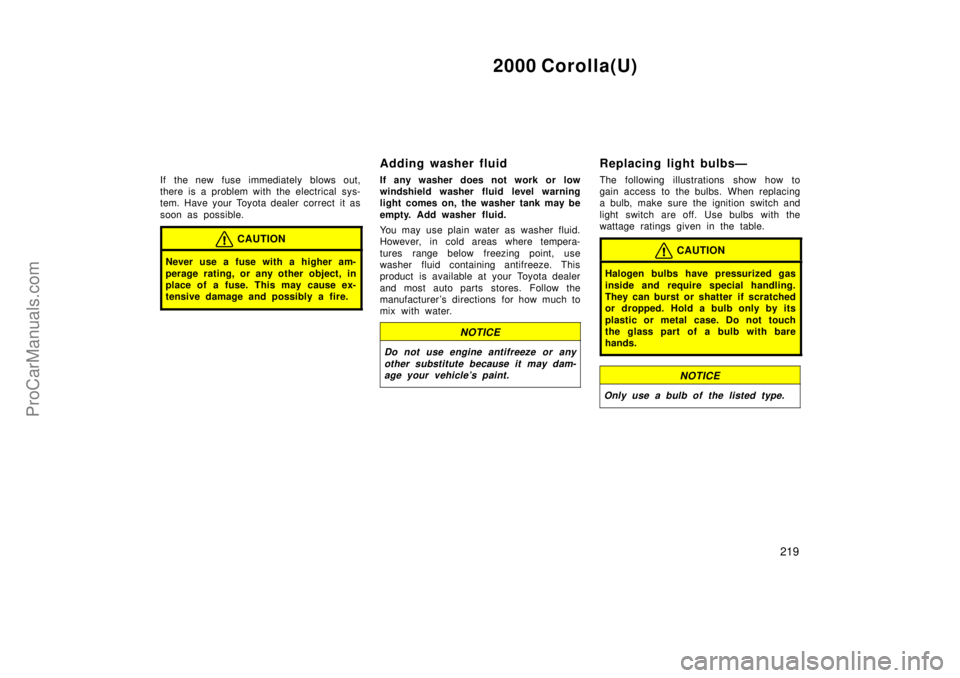Page 227 of 246

2000 Corolla(U)
209
To check the fluid level, simply look at
the see- through reservoir. The level
should be between the MAXº and
MINº lines on the reservoir.
It is normal for the brake fluid level to go
down slightly as the brake pads wear. So
be sure to keep the reservoir filled.
If the reservoir needs frequent refilling, it
may indicate a serious mechanical prob-
lem.
If the level is low, add SAE J1703 or
FMVSS No.116 DOT 3 brake fluid to the
brake reservoir.
Remove and replace the reservoir cover
by hand.Use only newly opened brake fluid. Once
opened, brake fluid absorbs moisture from
the air, and excess moisture can cause a
dangerous loss of braking.
CAUTION
Take care when filling the reservoir
because brake fluid can harm your
eyes and damage painted surfaces. If
fluid gets in your eyes, flush your
eyes with clean water.
NOTICE
If you spill some of the fluid, be sure
to wash it off with water to prevent
it from damaging the parts or paint.
Checking power steering fluid
If hot
addIf cold
add If cold
O.K. If hot O.K.
CloseOpen
Check the fluid level through the reser-
voir. If necessary, add automatic trans-
mission fluid DEXRON� II or III.
If the vehicle has been driven around 80
km/h (50 mph) for 20 minutes (a little
more in frigid temperatures), the fluid is
hot (60�CÐ80�C or 140�FÐ175�F). You
may also check the level when the fluid
is cold (about room temperature,
10�CÐ30�C or 50�FÐ85�F) if the engine
has not been run for about five hours.
ProCarManuals.com
Page 232 of 246

2000 Corolla(U)
214
Replacing wheels
WHEN TO REPLACE YOUR WHEELS
If you have wheel damage such as
bending, cracks or heavy corrosion, the
wheel should be replaced.
If you fail to replace damaged wheels, the
tire may slip off the wheel or cause loss
of handling control.
WHEEL SELECTION
When replacing wheels, care should be
taken to ensure that the wheels are re-
placed by ones with the same load ca-
pacity, diameter, rim width, and offset.
This must be observed on compact spare
tires, too.
Correct replacement wheels are available
at your Toyota dealer.
A wheel of a different size or type may
adversely affect handling, wheel and bear-
ing life, brake cooling, speedometer/odom-
eter calibration, stopping ability, headlight
aim, bumper height, vehicle ground clear-
ance, and tire or snow chain clearance to
the body and chassis.Replacement with used wheels is not rec-
ommended as they may have been sub-
jected to rough treatment or high mileage
and could fail without warning. Also, bent
wheels which have been straightened may
have structural damage and therefore
should not be used. Never use an inner
tube in a leaking wheel which is designed
for a tubeless tire.
Aluminum wheel precautions
�After driving your vehicle the first 1600
km (1000 miles), check that the wheel
nuts are tight.
�If you have rotated, repaired, or
changed your tires, check that the
wheel nuts are still tight after driving
1600 km (1000 miles).
�When using tire chains, be careful not
to damage the aluminum wheels.
�Use only the Toyota wheel nuts and
wrench designed for your aluminum
wheels.
�When balancing your wheels, use only
Toyota balance weights or equivalent
and a plastic or rubber hammer.
�As with any wheel, periodically check
your aluminum wheels for damage. If
damaged, replace immediately.
ProCarManuals.com
Page 233 of 246
2000 Corolla(U)
215
DO- IT- YOURSELF MAINTENANCE
Electrical components
Checking battery condition216 . . . . . . . . . . . . . . . . . . . . . . . . . . . . . . . . . .
Battery recharging precautions217 . . . . . . . . . . . . . . . . . . . . . . . . . . . . . . .
Checking and replacing fuses218 . . . . . . . . . . . . . . . . . . . . . . . . . . . . . . . .
Adding washer fluid219 . . . . . . . . . . . . . . . . . . . . . . . . . . . . . . . . . . . . . . . . .
Replacing light bulbs219 . . . . . . . . . . . . . . . . . . . . . . . . . . . . . . . . . . . . . . . .
SECTION 7- 3
ProCarManuals.com
Page 234 of 246

2000 Corolla(U)
216
CAUTION
BATTERY PRECAUTIONS
The battery produces flammable and
explosive hydrogen gas.
�Do not cause a spark from the bat-
tery with tools.
�Do not smoke or light a match near
the battery.
The electrolyte contains poisonous
and corrosive sulfuric acid.
�Avoid contact with eyes, skin or
clothes.
�Never ingest electrolyte.
�Wear protective safety glasses when
working near the battery.
�Keep children away from the bat-
tery.
EMERGENCY MEASURES
�If electrolyte gets in your eyes,
flush your eyes with clean water
immediately and get immediate
medical attention. If possible, con-
tinue to apply water with a sponge
or cloth while en route to the medi-
cal office.
�If electrolyte gets on your skin,
thoroughly wash the contact area. If
you feel pain or burning, get medi-
cal attention immediately.
�If electrolyte gets on your clothes,
there is a possibility of its soaking
through to your skin, so immediate-
ly take off the exposed clothing and
follow the procedure above, if nec-
essary.
�If you accidentally swallow electro-
lyte, drink a large quantity of water
or milk. Follow with milk of magne-
sia, beaten raw egg or vegetable
oil. Then go immediately for emer-
gency help.
ÐChecking battery exterior
TerminalsGround cable
Hold- down
clamp
Check the battery for corroded or loose
terminal connections, cracks, or loose
hold- down clamp.
a. If the battery is corroded, wash it off
with a solution of warm water and bak-
ing soda. Coat the outside of the termi-
nals with grease to prevent further cor-
rosion.
b. If the terminal connections are loose,
tighten their clamp nutsÐbut do not
overtighten.
c. Tighten the hold- down clamp only
enough to keep the battery firmly in
place. Overtightening may damage the
battery case.
Checking battery conditionÐ
ÐPrecautions
ProCarManuals.com
Page 235 of 246

2000 Corolla(U)
217
NOTICE
�Be sure the engine and all accesso-
ries are off before performing main-
tenance.
�When checking the battery, remove
the ground cable from the negative
terminal (- º mark) first and rein-
stall it last.
�Be careful not to cause a short cir-
cuit with tools.
�Take care no solution gets into the
battery when washing it.
ÐChecking battery fluid
Ty p e A
Ty p e BGreen DarkClear or
light yellow
Blue White Red
CHECKING BY HYDROMETER
Check the battery condition by the
hydrometer color.
Hydrometer color
ConditionTy p e ATy p e BCondition
GREENBLUEGood
DARKWHITE
Charging necessary.
Have battery
checked by your
Toyota dealer.
CLEAR
or
LIGHT
YELLOW
RED
Have battery
checked by your
Toyota dealer.
Battery recharging precautions
During recharging, the battery is pro-
ducing hydrogen gas.
Therefore, before recharging:
1. If recharging with the battery installed
on the vehicle, be sure to disconnect
the ground cable.
2. Be sure the power switch on the re-
charger is off when connecting the
charger cables to the battery and when
disconnecting them.
CAUTION
�Always charge the battery in an un-
confined area. Do not charge the
battery in a garage or closed room
where there is not sufficient ventila-
tion.
�Only do a slow charge (5A or less).
Charging at a quicker rate is dan-
gerous. The battery may explode,
causing personal injuries.
NOTICE
Never recharge the battery while the
engine is running. Also, be sure all
accessories are turned off.
ProCarManuals.com
Page 236 of 246

2000 Corolla(U)
218
Checking and replacing fuses
Ty p e A
Ty p e C Ty p e BGood Blown
Good Good
Blown Blown
If the headlights or other electrical
components do not work, check the
fuses. If any of the fuses are blown,
they must be replaced.
See Fuse locationsº in Section 7- 1 for
locations of the fuses.
Turn the ignition switch and inoperative
component off. Pull a suspected fuse
straight out and check it.
Determine which fuse may be causing the
problem. The lid of the fuse box shows
the name of the circuit for each fuse. See
Section 8 of this manual for the functions
controlled by each circuit.Type A fuses can be pulled out by the
pull- out tool. The location of the pull- out
tool is shown in the illustration.
If you are not sure whether the fuse has
blown, try replacing the suspected fuse
with one that you know is good.
If the fuse has blown, push a new fuse
into the clip.
Only install a fuse with the amperage rat-
ing designated on the fuse box lid.
If you do not have a spare fuse, in an
emergency you can pull out the FOGº or
S- HTRº fuse, which may be dispensable
for normal driving, and use it if its
amperage rating is the same.
If you cannot use one of the same amper-
age, use one that is lower, but as close
as possible to, the rating. If the amperage
is lower than that specified, the fuse
might blow out again but this does not
indicate anything wrong. Be sure to get
the correct fuse as soon as possible and
return the substitute to its original clip.
It is a good idea to purchase a set of
spare fuses and keep them in your ve-
hicle for emergencies.
ProCarManuals.com
Page 237 of 246

2000 Corolla(U)
219
If the new fuse immediately blows out,
there is a problem with the electrical sys-
tem. Have your Toyota dealer correct it as
soon as possible.
CAUTION
Never use a fuse with a higher am-
perage rating, or any other object, in
place of a fuse. This may cause ex-
tensive damage and possibly a fire.
Adding washer fluid
If any washer does not work or low
windshield washer fluid level warning
light comes on, the washer tank may be
empty. Add washer fluid.
You may use plain water as washer fluid.
However, in cold areas where tempera-
tures range below freezing point, use
washer fluid containing antifreeze. This
product is available at your Toyota dealer
and most auto parts stores. Follow the
manufacturer 's directions for how much to
mix with water.
NOTICE
Do not use engine antifreeze or any
other substitute because it may dam-
age your vehicle's paint.
Replacing light bulbsÐ
The following illustrations show how to
gain access to the bulbs. When replacing
a bulb, make sure the ignition switch and
light switch are off. Use bulbs with the
wattage ratings given in the table.
CAUTION
Halogen bulbs have pressurized gas
inside and require special handling.
They can burst or shatter if scratched
or dropped. Hold a bulb only by its
plastic or metal case. Do not touch
the glass part of a bulb with bare
hands.
NOTICE
Only use a bulb of the listed type.
ProCarManuals.com
Page 238 of 246
2000 Corolla(U)
220
Light bulbsBulb
No.WTy p e
HeadlightsÐ60/55A
Parking, front side
marker and front
turn signal lights3157NA27/8C
Rear side marker
lights1943.8C
Rear turn signal
lights315627C
Stop and tail lights315727/8C
Back- up lights92118C
License plate lights1943.8C
High mounted
stoplight92118C
Personal lightÐ10B
Interior lightÐ8D
Trunk light1684.9C
A: HB2 halogen bulbs
B: Single end bulbs
C: Wedge base bulbs
D: Double end bulbs
ÐHeadlights
1. Open the hood.
RIGHT- HAND HEADLIGHT: Remove
the bolts and take out the relay
block.
Put the relay block in the appropriate
place other than on the engine.
NOTICE
Do not place the relay block on the
engine.
2. LEFT- HAND HEADLIGHT: Remove the
clip and take out the air cleaner
duct.
Remove and install the cover clip as
shown in the following illustration.
ProCarManuals.com